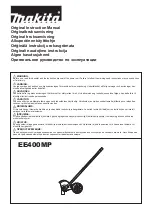
Test Procedure (continued)
3. Clean the junction of the hydraulic hoses and straight fittings at the hydraulic
motor (
). Tag the hoses to correspond with the motor ports (A and
B) then disconnect the hoses from the fittings. Cap the motor fittings to
prevent contamination from entering the system.
g271745
Figure 24
1.
Hydraulic motor
3.
Hose – motor B port (travel right)
2.
Hose – motor A port (travel left)
IMPORTANT
To prevent hydraulic tester damage, make sure that the oil flow
direction indicator on the tester is installed so the oil will flow from
the disconnected motor B port hydraulic hose, through the tester
and into the disconnected motor A port hydraulic hose.
4. Install the hydraulic tester (flow and pressure) in series with the disconnected
hoses.
5. Make sure the flow control valve on the tester is fully open.
6. Start the engine and run it at low-idle speed. Check for hydraulic fluid leaks
from the test connections and correct before continuing the test.
7. Set the throttle to full engine speed
(3,600 rpm)
. Use a non-contact
tachometer (phototach) to verify the engine speed.
8. Verify the pump flow at No Load as follows:
A. Sit in the operator’s seat, disengage the parking brake and slowly press
and hold the
RIGHT
motion control pedal at the full forward position.
Hydraulic System: Testing the Hydraulic System
Page 5–26
GreensPro
™
1240/1260
14211SL Rev A
Summary of Contents for GreensPro 1240
Page 4: ...Reader Comments Page 4 GreensPro 1240 1260 14211SL Rev A...
Page 8: ...Preface Page 8 GreensPro 1240 1260 14211SL Rev A...
Page 14: ...Safety Safety and Instructional Decals Page 1 6 GreensPro 1240 1260 14211SL Rev A...
Page 30: ...Specifications and Maintenance Special Tools Page 2 16 GreensPro 1240 1260 14211SL Rev A...
















































